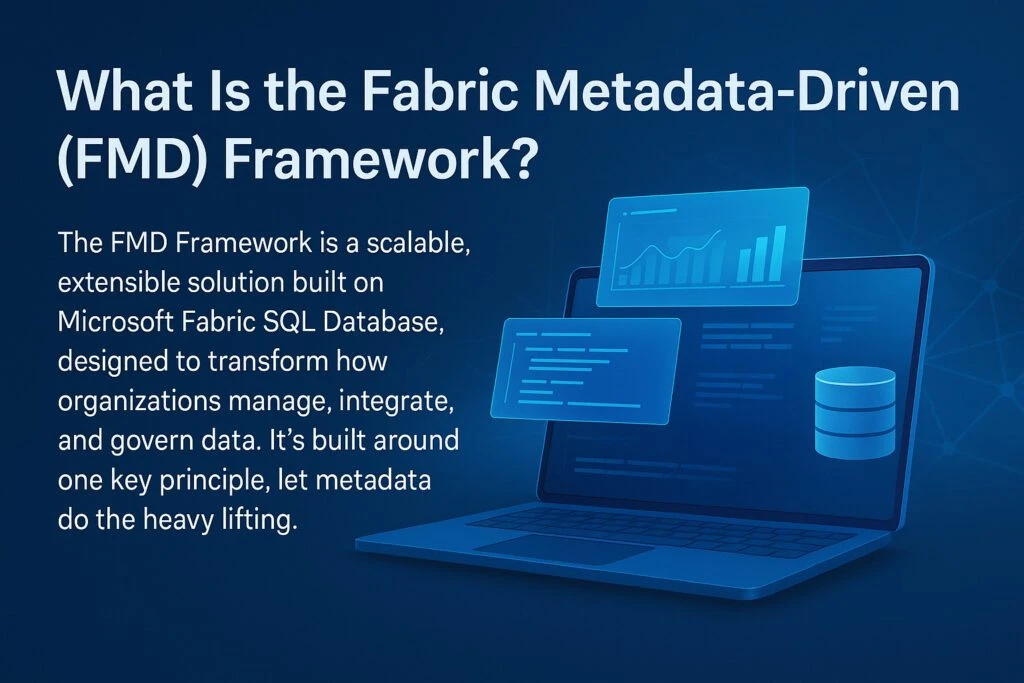What Is the Fabric Metadata-Driven (FMD) Framework?
The FMD Framework is a scalable, extensible solution built on Microsoft Fabric SQL Database, designed to transform how organizations manage, integrate, and govern data. It’s built around one key principle, let metadata do the heavy lifting.

Instead of hardcoding every connection, transformation, and rule, the FMD Framework dynamically drives data pipelines, configurations, and workflows from metadata tables. The result? Faster deployments, consistent logic, and a framework that evolves effortlessly as business needs change.
Key Highlights:
- Comprehensive Governance: Centralize metadata for better quality, consistency, and compliance.
- Scalability and Flexibility: Adapt easily to new sources, schemas, and scaling needs.
- Streamlined Integration: Connect diverse systems, from SQL to flat files, without rebuilding pipelines.
- Cost Efficiency: Eliminate redundancy and optimize compute costs with metadata-driven automation.
Inside the Architecture: Simplicity Meets Power
At its core, the FMD Framework follows a modular architecture that separates data, code, and orchestration. This not only improves manageability but also enhances security and traceability.
Workspace Architecture
| Workspace Type | Purpose | Examples |
| Data Workspaces | Manage and store data | Data Landing Zone, Bronze, Silver |
| Code Workspaces | Develop pipelines and notebooks | Data Pipelines, Spark, Scripts |
| Gold Workspaces | Host business-ready datasets | Gold Layer, Semantic Models |
| Reporting Workspaces | Create business intelligence | Power BI Reports |
| Orchestration & Logging | Manage operations and audits | Fabric SQL Database, Audit Tables |
This structure ensures clear separation of responsibility, smoother collaboration, and cleaner governance, exactly what enterprises struggle to achieve in fragmented data environments.
How Microsoft Fabric Powers Metadata-Driven Pipelines
Fabric’s OneLake and Lakehouse medallion architecture, the Bronze-Silver-Gold layering, fit perfectly with a metadata-driven strategy.
Here’s how it all comes together:
- Define Metadata Tables: Store all ingestion rules, parameters, and configurations dynamically.
- Lookup Metadata at Runtime: Pipelines fetch instructions from the metadata layer, no code changes required.
- Trigger Data Movement: Based on metadata, data flows from raw (Bronze) to refined (Silver) to business-ready (Gold).
- Monitor & Audit: Logs track every step, ensuring complete transparency and traceability.
With this, onboarding a new data source becomes as simple as updating a few metadata records, no new code, no redeployment, no drama.
Why Traditional Data Engineering Falls Short
Let’s be honest, most data workflows today are a tangled mess. Pipelines break when schemas change, naming conventions vary wildly, and governance feels like an afterthought.
In mergers, acquisitions, or modernization projects, onboarding new sources can drag on for weeks. Every team brings its own standards, and manual mapping only adds more room for errors.
Even though Microsoft Fabric provides cutting-edge tools like lakehouses, warehouses, and notebooks, without a standardized, metadata-driven framework, teams often find themselves reinventing the wheel.
Metadata changes that. It brings structure, repeatability, and control. With clearly defined metadata schemas, transformations can be applied consistently, audits become effortless, and pipelines gain resilience. It’s not just about automation, it’s about regaining control of your data ecosystem.
Building a Modular, Future-Ready Solution
The FMD Framework is built on six modular layers, each playing a crucial role:

- System Definition: Registers every data source (Azure SQL, Oracle, flat files) and defines connection properties.
- System Mapping: Links sources to targets, specifying how data should flow—via pipelines, notebooks, or stored procedures.
- Object Mapping: Defines tables, files, execution order, parallel groups, and load strategies.
- Transformation Logic: Encodes field-level and group-level transformations using SQL or PySpark, all metadata-driven.
- Workflow Orchestration: Coordinates sequence, retries, and dependencies dynamically.
- Stage Management: Tracks progress, failure, and restarts, providing full visibility into pipeline health.
Every stage is parameterized and restartable, allowing seamless promotion from dev to prod with minimal DevOps dependency. Workflows are JSON-driven, so configurations can evolve without changing the underlying code.
The Heart of Automation: Configuration Tables
At the core of this automation lie meticulously designed configuration tables:
- System & Mapping Tables: Define data sources and relationships.
- Object Mapping: Details ingestion logic, parallelism, and sequence.
- Transformation Configuration: Specifies transformation scripts and rules.
- Workflow & Stage Management: Controls orchestration and monitoring.
- Audit Tables: Capture complete lineage and execution logs.
Adding a new source? Just duplicate a row, tweak the parameters, and the framework does the rest. From connection setup to data transformation, Fabric pipelines self-configure based on metadata instructions.
It’s like teaching your data system to think for itself.
Breaking Barriers: Real-World Success Stories
Designing the metadata schema wasn’t easy. Too abstract, and people got lost; too rigid, and it couldn’t scale. The breakthrough came from balancing simplicity with flexibility, creating metadata definitions that both developers and analysts could grasp quickly.
A memorable success story came during a major migration from on-prem SQL Server to Microsoft Fabric. Instead of rewriting dozens of pipelines, we defined ingestion and transformation logic in metadata. Fabric’s SQL and notebooks took care of orchestration, enabling a clean, traceable migration, faster, cheaper, and far less error-prone.
Another big win? Reducing onboarding time for new data sources from three weeks to just a few days. Developers no longer duplicated logic; governance teams gained full audit visibility; project managers could finally predict timelines accurately.
The framework didn’t just automate workflows, it created confidence across the data lifecycle.
Why This Matters for Your Business
In an era where data drives every decision, agility is everything. But agility doesn’t come from writing faster code, it comes from building smarter systems.
The FMD Framework empowers organizations to:
- Accelerate cloud migrations to Microsoft Fabric with minimal rework.
- Standardize data pipelines for multi-source integrations.
- Achieve operational excellence with traceable, reusable logic.
- Reduce costs and risk by eliminating manual inefficiencies.
If your organization handles complex data flows or frequently onboards new sources, this approach can redefine your productivity curve.
Conclusion: A New Mindset for Modern Data Engineering
The Fabric Metadata-Driven Framework is more than just a technical architecture, it’s a mindset shift. It replaces chaos with clarity, repetition with automation, and uncertainty with transparency.
For data engineers, it means less firefighting.
For architects, it means reliable scalability.
For business leaders, it means faster time-to-value and measurable ROI.
If you’re exploring Microsoft Fabric for cloud migration or seeking a resilient, metadata-first approach to analytics, this framework could be your game-changer.
Let’s connect, collaborate, and reimagine what enterprise data can achieve, one metadata table at a time.




